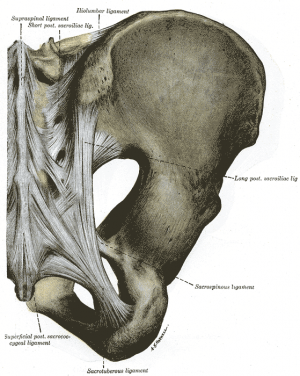Long dorsal sacroiliac ligament (LDL) test
Purpose[edit | edit source]
The long dorsal sacral ligament test is a pain provoking test typically used in combination with the posterior pelvic pain provocation test and the active straight leg raise test (ASLR) when a patient presents with lumbopelvic and/or sacroiliac joint pain.
Anatomy[edit | edit source]
The long dorsal sacral ligament originates on the lateral crest of the third and fourth sacral segments.[1] The long dorsal sacral ligament has close relations with, the aponeurosis of the erector spinae muscle, the posterior layer of the thoracolumbar fascia, and the sacrotuberous ligament.[2] Counternutation in the sacroiliac joint will increase tension on the long dorsal sacral ligament and nutation will slacken the ligament.[1] The ligament can be palpated by locating the posterior superior iliac spine (PSIS) and moving just caudal to the PSIS.
Technique[edit | edit source]
The Long dorsal sacral ligament test in postpartum women[1]
The patient lies prone and will be examined for tenderness on bilateral palpation of the LDL directly under the caudal part of the posterior superior iliac spine. The pain will be scored by a skilled examiner on a 4-point scale :
0 : no pain
1 : mild pain
2 : moderate pain
3 : unbearable pain
The sum score can be situated between 0-6 because the scores on both sides are added.
The Long dorsal sacral ligament test in pregnant women[1]
The patient lies on her side with slight flexion in both hip and knee joints. If the pain caused by the palpation remains for more than 5 seconds after the examiner removes his hand, it is considered as pain. It is considered as tenderness when the pain disappears within 5 seconds.
Evidence[edit | edit source]
References[edit | edit source]
- ↑ 1.0 1.1 1.2 1.3 Vleeming A, Albert HB, Östgaard HC, Sturesson B, Stuge B. European guidelines for the diagnosis and treatment of pelvic girdle pain. European Spine Journal Jun 2008; 17(6) : 794-819.
- ↑ Vleeming A, Pool-Goudzwaard AL, Hammudoghlu D, Stoeckart R, Snijders CJ, Mens JM. The function of the long dorsal sacroiliac ligament: its implication for understanding low back pain. Spine. 1996 Mar 1;21(5):556-62.







